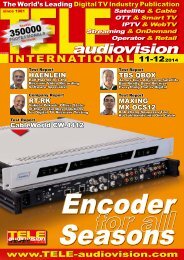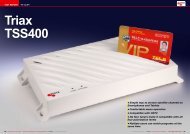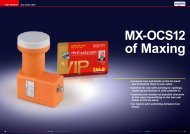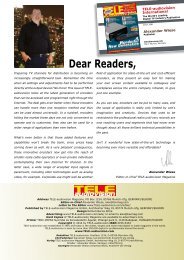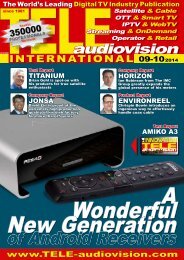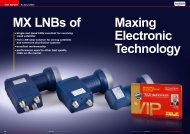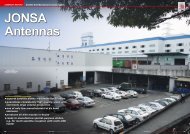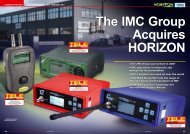Titanium ASC1
Create successful ePaper yourself
Turn your PDF publications into a flip-book with our unique Google optimized e-Paper software.
TEST REPORT<br />
Positioner for Big Satellite Dish<br />
<strong>Titanium</strong><br />
<strong>ASC1</strong><br />
• Robust heavy duty positioner<br />
• Can drive the largest dishes<br />
• Fully DiSEqC-1.2 compatibility for use<br />
with modern receivers<br />
• Can be used as a stand-alone device to<br />
move the dish<br />
• Configurable through a PC<br />
60 TELE-audiovision International — The World‘s Leading Digital TV Industry Publication — 09-10/2014 — www.TELE-audiovision.com<br />
www.TELE-audiovision.com — 09-10/2014 — TELE-audiovision International — 全 球 发 行 量 最 大 的 数 字 电 视 杂 志 61
TEST REPORT<br />
Positioner for Big Satellite Dish<br />
The Best Way to Move your<br />
Big Dish to any Position<br />
The <strong>Titanium</strong> <strong>ASC1</strong> is a<br />
true heavy-duty dish positioner.<br />
It’s appearance is<br />
very impressive; much different<br />
from those common<br />
positioners that come in<br />
small plastic boxes. It actually<br />
looks like it was built for<br />
military use: heavy, massive<br />
and robust; any satellite<br />
enthusiast’s heart will jump<br />
www.TELE-audiovision.com/14/09/titanium<br />
09-10/2014<br />
<strong>Titanium</strong> <strong>ASC1</strong> Positioner<br />
Best positioner on the market and a real<br />
bargain in terms of versatility, functionality<br />
and sheer construction quality<br />
just looking at it - at least<br />
our hearts went into overdrive!<br />
The internal components<br />
are protected by two heavy<br />
steel plates with the product<br />
name <strong>Titanium</strong> engraved on<br />
the top. These plates have<br />
a hole on each side large<br />
enough for your hands that<br />
lets you easily carry the <strong>Titanium</strong><br />
<strong>ASC1</strong>. You can even<br />
take the positioner right up<br />
to the dish when setting it<br />
up (i.e. to define the limits<br />
of the actuator). The overall<br />
design looks great and is<br />
very practical.<br />
The <strong>Titanium</strong>’s case is<br />
painted in a matt black color<br />
and the front features an<br />
unusually large LCD display<br />
capable of displaying 4 lines<br />
with 20 characters each –<br />
more than enough to completely<br />
control every function.<br />
To the left side of the<br />
display are the buttons that<br />
let you navigation within<br />
the menu structure as well<br />
as two big buttons to drive<br />
the dish east and west. The<br />
front panel also contains the<br />
IR-receiver for the remote<br />
control. Spoiler alert: you do<br />
not need to read the manual<br />
to use the <strong>Titanium</strong> <strong>ASC1</strong>; it<br />
is really easy to use.<br />
On the back panel you’ll<br />
find the typical connectors<br />
for one actuator and the<br />
skew control as well as a<br />
power socket (you can plug<br />
in a regular grounded power<br />
cable – no external power<br />
adapter is needed) and an<br />
RS-232 port with a DB9 connector.<br />
There are two LNB<br />
jacks to connect the LNB and<br />
the receiver if you want to<br />
control the <strong>Titanium</strong> <strong>ASC1</strong><br />
through DiSEqC 1.2. The included<br />
remote control is a<br />
simple, yet comfortable, design<br />
that lets you fully control<br />
the <strong>Titanium</strong> <strong>ASC1</strong>.<br />
Finally, there is a fuse<br />
compartment in the unlikely<br />
event of a short circuit or a<br />
power spike. We appreciated<br />
this extra level of protection;<br />
unfortunately, accidents do<br />
happen no matter how careful<br />
you try to be...<br />
At first the size of this positioner<br />
caught us by surprise.<br />
Well, it turns out it’s<br />
not just for show. Just like<br />
62 TELE-audiovision International — The World‘s Leading Digital TV Industry Publication — 09-10/2014 — www.TELE-audiovision.com<br />
www.TELE-audiovision.com — 09-10/2014 — TELE-audiovision International — 全 球 发 行 量 最 大 的 数 字 电 视 杂 志 63
with premium audio amplifiers,<br />
which are similar in size,<br />
it is big for a reason: there’s<br />
a huge power transformer<br />
inside the chassis. Large<br />
transformers like that generally<br />
need to be protected<br />
and cooled, but since a fan<br />
can be the source of really<br />
annoying noise, the <strong>Titanium</strong><br />
<strong>ASC1</strong> was constructed with<br />
two steel plates with air inlets<br />
on the side to keep everything<br />
cool.<br />
So why does the <strong>Titanium</strong><br />
<strong>ASC1</strong> need such a<br />
large transformer inside in<br />
the first place? Because in<br />
this way it can drive actuators<br />
that draw as much as 5<br />
Amps. Take the largest polar<br />
mount you can find, install<br />
it on the biggest dish you<br />
can buy and the <strong>Titanium</strong><br />
<strong>ASC1</strong> can drive it without<br />
any effort. Other positioners<br />
provide much less power<br />
and therefore would have a<br />
much harder time trying to<br />
move heavy dishes.<br />
Another unique aspect of<br />
the <strong>Titanium</strong> <strong>ASC1</strong> is the<br />
fact that it can work as a<br />
standalone device. It easily<br />
replaces older generation<br />
receivers that have an inte-<br />
Firmware<br />
Upgrade<br />
1<br />
Before we tried out the<br />
<strong>Titanium</strong> <strong>ASC1</strong> in the field<br />
we checked the <strong>Titanium</strong><br />
website (www.titaniumsatellite.com)<br />
and downloaded<br />
its latest firmware. In fact,<br />
<strong>Titanium</strong> does invest a lot of<br />
resources improving every<br />
detail of the <strong>Titanium</strong> <strong>ASC1</strong> and as a result, the<br />
user can benefit from frequent firmware upgrades.<br />
The upgrade process is very simple: just download<br />
the ZIP archive containing the binary file.<br />
Laudable: a text file is included which lists all<br />
changes of the firmware. After unzipping the firmware<br />
binary file (*.bin extension), we just had to<br />
use the included <strong>Titanium</strong> Loader/Editor software<br />
and select the Firmware Upgrade function. We<br />
were asked to select the firmware file and to press<br />
a button to start the process, which took less than<br />
one minute. We appreciated the fact that the software<br />
confirmed that the firmware has in fact been<br />
flashed correctly: it is always nice to get that kind<br />
of feedback.<br />
2<br />
1. Unzipping the archive shows the two files: the binary file for the<br />
firmware and a text file explaining the firmware changes<br />
2. The new firmware has been successfully loaded into the <strong>Titanium</strong><br />
<strong>ASC1</strong><br />
64 TELE-audiovision International — The World‘s Leading Digital TV Industry Publication — 09-10/2014 — www.TELE-audiovision.com
■<br />
The <strong>Titanium</strong> <strong>ASC1</strong> is very heavy, so what's inside? A huge<br />
transformer that will drive the biggest dish thanks to its 5 amp<br />
output. We also found exceptionally well designed PCBs with<br />
professional cables. Everything is assembled with great care.<br />
Thumbs up to <strong>Titanium</strong> for excellent workmanship!<br />
grated 36V actuator control.<br />
There are many enthusiasts<br />
out there that still use<br />
these older receivers just to<br />
move their dishes and use<br />
modern receivers to watch<br />
TV. These same enthusiasts<br />
probably wouldn’t want to<br />
part with their modern receiver;<br />
instead they could<br />
replace their old receiver/<br />
positioner with this modern<br />
version and keep everything<br />
else just the same, especially<br />
since the modern receiver<br />
may already be set up with<br />
custom satellite settings and<br />
thousands of channels.<br />
However, the <strong>Titanium</strong><br />
<strong>ASC1</strong> also supports DiS-<br />
EqC-1.2. This would let you<br />
hide the <strong>ASC1</strong> out of view<br />
and control everything via<br />
DiSEqC 1.2 commands that<br />
are supported by all of today’s<br />
modern receivers.<br />
Thanks to the big LCD display,<br />
the <strong>Titanium</strong> <strong>ASC1</strong> can<br />
be used without being connected<br />
to any TV or receiver.<br />
Of course, normally you<br />
would usually do this only<br />
during the initial setup, but<br />
the <strong>ASC1</strong> makes it extremely<br />
convenient: once the actuator<br />
is connected to the dish,<br />
you would want to be able<br />
to drive the dish from east<br />
to west and back again to<br />
check the mechanical installation.<br />
You would also want<br />
to be able set the hardware<br />
limits of the actuator and<br />
normally you would want<br />
to set the software limits<br />
as well. The <strong>Titanium</strong> <strong>ASC1</strong><br />
makes it possible to do all of<br />
this without having to connect<br />
a receiver. This is really<br />
an outstanding feature!<br />
If you ever have to correct<br />
something on your dish, you<br />
3<br />
Editor Software<br />
4<br />
The <strong>Titanium</strong> Loader/Editor software<br />
which we used to upgrade the<br />
firmware can be used to edit and customize<br />
the <strong>Titanium</strong> <strong>ASC1</strong>’s satellite<br />
configuration. It wouldn’t make sense<br />
to try to edit satellite names on the<br />
<strong>Titanium</strong> itself, at least it would not<br />
be a comfortable thing to do.<br />
Using the PC is much better and<br />
quicker, especially because the <strong>Titanium</strong><br />
website offers complete satellite<br />
lists for different regions. These<br />
lists are *.CSV files, which can be<br />
edited using Excel. This means that<br />
you could, for example, get your desired<br />
satellite list from your favorite<br />
listings website and adjust it to the<br />
required format using Excel.<br />
The format is simple; it contains<br />
just four columns: the name of the<br />
satellite with up to 14 characters, the<br />
position (number of actuator impulses),<br />
the horizontal skew and the vertical<br />
skew (both as an angle).<br />
We enjoyed this widely open format<br />
and noticed that the <strong>Titanium</strong> Loader/Editor<br />
software is very straight<br />
forward to use, too. You can download<br />
the satellite configuration from<br />
the <strong>Titanium</strong> <strong>ASC1</strong> or upload to it.<br />
These processes take about a minute<br />
and it feels very reassuring to have a<br />
backup of the satellite configuration<br />
on a PC.<br />
This allows maintaining multiple<br />
profiles in case you really need more<br />
than 99 satellite configurations (or<br />
200 satellite configurations with the<br />
soon to be released new firmware).<br />
You could have a Ku-band profile<br />
and a C-band profile and swap it as<br />
needed.<br />
3. Excel could be used to edit this<br />
satellite list for the <strong>Titanium</strong> <strong>ASC1</strong><br />
4. Another option is to edit the satellite<br />
list with the <strong>Titanium</strong> Loader/Editor<br />
software<br />
66 TELE-audiovision International — The World‘s Leading Digital TV Industry Publication — 09-10/2014 — www.TELE-audiovision.com
5<br />
5. Here‘s where we<br />
conducted our test of<br />
the <strong>Titanium</strong> <strong>ASC1</strong>. This<br />
is where ‚Feedsat‘, a well<br />
known satellite enthusiast,<br />
has installed several large<br />
dishes in the South of France.<br />
On a side note: Feedsat’s<br />
garden is the perfect example on<br />
how to set up oversized dishes<br />
without ruining the harmony. Note:<br />
all cables run underground!<br />
6. First we lined up our equipment:<br />
a laptop, the Deviser S7000 meter,<br />
the <strong>Titanium</strong> <strong>ASC1</strong> and finally the old<br />
positioner that Feedsat has been using<br />
up until now for one of his dishes.<br />
6<br />
can simply carry the solidlybuilt<br />
<strong>Titanium</strong> <strong>ASC1</strong> out to<br />
the dish by one of its handles.<br />
Then connect to the<br />
actuator and a power source<br />
- you’ll then be able to drive<br />
the dish to any stored position,<br />
reset the limits, etc.<br />
And you don’t even have to<br />
be right next to the <strong>Titanium</strong><br />
<strong>ASC1</strong>; just use the included<br />
remote control. And yes, we<br />
did try it: it works outside<br />
under full sunlight.<br />
In fact, to really check<br />
out all of the capabilities offered<br />
by the <strong>Titanium</strong> <strong>ASC1</strong>,<br />
we paid a visit to one of the<br />
best known satellite enthusiasts<br />
in Europe: ‘Feedsat’,<br />
as he is known all over the<br />
Internet forums and blogs.<br />
Feedsat has quite a remarkable<br />
garden in the South of<br />
France: between perfectly<br />
trimmed grass, a pond and<br />
a swimming pool, you will<br />
find two prime focus dishes,<br />
one with a diameter of 3.1m<br />
plus polar mount, the other<br />
is currently 2.8m in diameter<br />
(soon to be extended<br />
to 3.2m and equipped with<br />
a polar mount). There’s also<br />
a 1.8m offset dish. All three<br />
of these dishes are used for<br />
the C-band, but the smaller<br />
1.8m dish has a Ku-band<br />
LNB as well.<br />
Which of these dishes do<br />
you think we selected for<br />
testing the <strong>Titanium</strong> <strong>ASC1</strong>?<br />
Of course we opted for Feedsat’s<br />
largest dish, the Winegard<br />
10’ Pinnacle TVRO 3.1m<br />
dish, made in the USA. This<br />
is a really huge and heavy<br />
dish; the polar mount is massive<br />
and the installed actuator<br />
is hungry for power. In<br />
fact, most regular positioners<br />
would have a hard time<br />
driving this dish and would<br />
enter an over-current state.<br />
If you keep overdriving it,<br />
you might end up destroying<br />
the device.<br />
Not so with the <strong>Titanium</strong><br />
<strong>ASC1</strong>. After connecting the<br />
wires, which only required a<br />
few minutes, we were able<br />
to drive the dish back and<br />
forth without any effort. The<br />
movement of the actuator<br />
was always smooth and constant.<br />
To further test the <strong>Titanium</strong><br />
<strong>ASC1</strong> in actual use we<br />
68 TELE-audiovision International — The World‘s Leading Digital TV Industry Publication — 09-10/2014 — www.TELE-audiovision.com<br />
www.TELE-audiovision.com — 09-10/2014 — TELE-audiovision International — 全 球 发 行 量 最 大 的 数 字 电 视 杂 志 69
The <strong>Titanium</strong> <strong>ASC1</strong> menu<br />
connected one of our reference<br />
meters, the Deviser<br />
S7000 (presented in TELEaudiovision<br />
09-10/2013,<br />
you can read the test report<br />
here: www.TELE-audiovision.com/13/09/deviser).<br />
This allowed us to see the real-time<br />
spectrum and thanks<br />
to the waterfall diagram we<br />
could register and count all<br />
of the satellites featuring C-<br />
band transponders.<br />
At first we were using the<br />
<strong>Titanium</strong> <strong>ASC1</strong> directly to<br />
drive the dish. Having the remote<br />
control available made<br />
it so convenient to operate<br />
the dish that we almost forgot<br />
that we could also control<br />
the dish with the Deviser<br />
by using simple DiSEqC 1.2<br />
commands. Once we realized<br />
that we could do that,<br />
we went ahead and tried it<br />
out to make sure that all the<br />
possible DiSEqC 1.2 commands<br />
are really supported:<br />
GOTO, STORE, STEP, LIMIT<br />
and RESET.<br />
While the GOTOxx command<br />
is fairly standard and<br />
should have no trouble working<br />
on a positioner that is to<br />
be connected to a modern<br />
satellite receiver, we were<br />
not so sure about how well<br />
it would behave with the remaining<br />
commands.<br />
The first command we<br />
70 TELE-audiovision International — The World‘s Leading Digital TV Industry Publication — 09-10/2014 — www.TELE-audiovision.com
7. Connecting the wires: 2 thick ones (red and black)<br />
for the motor, 2 thin ones (red and black as well) for<br />
the sensor and the remaining 3 thin cables for the<br />
servo motor of the LNB (skew).<br />
8. The same applies to the positioner: here the cables<br />
are, of course, connected in the same manner<br />
7 8<br />
72 TELE-audiovision International — The World‘s Leading Digital TV Industry Publication — 09-10/2014 — www.TELE-audiovision.com
Ready,<br />
Set,<br />
Go!<br />
The <strong>Titanium</strong> <strong>ASC1</strong> had no problem whatsoever<br />
to turn the big 3.1m dish back and forth, from<br />
limit to limit. Speaking of limits: there will almost<br />
always be an obstacle limiting the movement of<br />
the dish. While it is normal to set the hardware<br />
limits on the actuator, which uses microswitches<br />
for this purpose, it can be useful and<br />
add a level of security if the software limits of the<br />
<strong>Titanium</strong> <strong>ASC1</strong> are set as well.<br />
1 2 3 4 5 6 7 8<br />
9 10 11 12 13 14 15 16<br />
17 18 19 20 21 22 23 24<br />
74 TELE-audiovision International — The World‘s Leading Digital TV Industry Publication — 09-10/2014 — www.TELE-audiovision.com<br />
www.TELE-audiovision.com — 09-10/2014 — TELE-audiovision International — 全 球 发 行 量 最 大 的 数 字 电 视 杂 志 75
9<br />
tested was the STEP command.<br />
This will move a motorized<br />
dish exactly one step<br />
to the east or to the west.<br />
It is up to the receiver or,<br />
like in our case, the meter,<br />
to implement functions to<br />
move more than one step at<br />
a time. The Deviser S7000<br />
allows the user to select how<br />
many seconds or how many<br />
steps are to be executed at a<br />
given time.<br />
The <strong>Titanium</strong> <strong>ASC1</strong> inter-<br />
9. To test the <strong>Titanium</strong> <strong>ASC1</strong>, we decided to set it up close to the<br />
dish. Here the big LCD display of the <strong>Titanium</strong> paid off, since we<br />
could set the limits and test the overall performance. The direct<br />
sunlight did not disturb us: the <strong>Titanium</strong>‘s display was bright<br />
enough.<br />
10. Satellite enthusiast ‚Feedsat‘ uses the <strong>Titanium</strong> <strong>ASC1</strong>‘s<br />
remote control to move the dish<br />
10<br />
76 TELE-audiovision International — The World‘s Leading Digital TV Industry Publication — 09-10/2014 — www.TELE-audiovision.com
preted the STEP command<br />
exactly as expected, transposing<br />
the steps on the polar<br />
mount. Interestingly, it did<br />
so with a precision of +/- 1<br />
step, which is as good as you<br />
could imagine.<br />
Next we tried the LIMIT<br />
command. This is normally<br />
used in DiSEqC 1.2 motors<br />
to set the software limits<br />
in order to prevent the dish<br />
from hitting any obstacle<br />
like a wall. Polar mounts normally<br />
come with hardware<br />
limit settings based on an<br />
actual switch, but this has to<br />
be set up on the dish. Defining<br />
a software limit provides<br />
an extra layer of security, a<br />
temporary limit or simply reduces<br />
the installation time.<br />
Traditional positioners do<br />
not provide the LIMIT function<br />
defined by the DiSEqC<br />
1.2 protocol, so we were<br />
curious to see how the <strong>Titanium</strong><br />
<strong>ASC1</strong> would react if<br />
we tried to set limits through<br />
our Deviser S7000. And<br />
sure enough, as soon as the<br />
limit was set on the Deviser<br />
S7000, the <strong>Titanium</strong> <strong>ASC1</strong><br />
would not move the polar<br />
mount any further than the<br />
limit.<br />
When we tried the ERASE<br />
LIMIT command on the Deviser,<br />
we hit a little snag:<br />
the <strong>Titanium</strong> <strong>ASC1</strong> refused<br />
to move beyond the previously<br />
defined limit. What<br />
was going on? Very simple:<br />
we should have looked at the<br />
LCD screen on the <strong>Titanium</strong><br />
<strong>ASC1</strong>. Each time we tried<br />
the ERASE LIMIT function,<br />
the <strong>Titanium</strong> <strong>ASC1</strong> was looking<br />
for a confirmation to really<br />
delete the limit. This is<br />
an excellent feature that will<br />
prevent any accidentally deleted<br />
limits and the potential<br />
costly consequences.<br />
The RESET command did<br />
not produce any effect on<br />
the <strong>Titanium</strong> <strong>ASC1</strong>, which<br />
is actually exactly what we<br />
expected and wanted. This<br />
command only makes sense<br />
on an integrated DiSEqC 1.2<br />
■<br />
'Feedsat' uses the<br />
Deviser S7000 to<br />
fine-tune the dish<br />
78 TELE-audiovision International — The World‘s Leading Digital TV Industry Publication — 09-10/2014 — www.TELE-audiovision.com<br />
www.TELE-audiovision.com — 09-10/2014 — TELE-audiovision International — 全 球 发 行 量 最 大 的 数 字 电 视 杂 志 79
Interview with<br />
Brian Gohl<br />
motor and we definitely don’t<br />
want to allow a satellite receiver<br />
to reset the settings<br />
of a dedicated positioner.<br />
Naturally, you can do a settings<br />
reset on the <strong>Titanium</strong><br />
<strong>ASC1</strong> itself by selecting the<br />
corresponding menu option,<br />
which then has to be confirmed.<br />
Finally, we set up the <strong>Titanium</strong><br />
<strong>ASC1</strong> in the shack<br />
where it replaced Feedsat’s<br />
existing age-old Echostar<br />
AD2500IP receiver. The <strong>Titanium</strong><br />
<strong>ASC1</strong> was setup as an<br />
stand-alone positioner without<br />
taking advantage of the<br />
DiSEqC 1.2 capabilities and<br />
Feedsat could start satellite<br />
surfing with the <strong>Titanium</strong><br />
<strong>ASC1</strong> just like he did before<br />
with his Echostar.<br />
The <strong>Titanium</strong> <strong>ASC1</strong> can<br />
store up to 99 satellite configurations,<br />
storing for each<br />
configuration the position<br />
and the horizontal and vertical<br />
skew rotation. You can<br />
give each satellite configuration<br />
a name of up to 14<br />
characters, which should be<br />
more than enough.<br />
However, for a hardcore<br />
satellite enthusiast, 99 satellite<br />
configurations may not<br />
be quite enough when you<br />
consider that in well served<br />
locations such as in central<br />
Europe you can receive an<br />
amazing number of satellites<br />
- at Feedsat’s location where<br />
we performed our tests, 74<br />
satellite positions from 76.0E<br />
to 63.0W could be accessed<br />
at the time of our test. With<br />
a multi-feed configuration<br />
using two LNBs (i.e. one Ku-<br />
Band LNB in focus and one<br />
C-Band on the side), you<br />
now have 148 positions. So<br />
we contacted Brian Gohl, the<br />
owner of <strong>Titanium</strong> and developer<br />
of the positioner, and<br />
he immediately responded<br />
by promising to increase the<br />
number of satellite positions<br />
to 200 in the next firmware<br />
update.<br />
One of the biggest advantages<br />
of the <strong>Titanium</strong> <strong>ASC1</strong><br />
is its the versatility. You can<br />
drive any oversized dish and<br />
you can use it as a standalone<br />
or transparent DiSEqC<br />
1.2 positioner – anything<br />
is possible.<br />
This is the definitive positioner;<br />
you buy it only once<br />
and it will last a lifetime. You<br />
can use it for dishes both<br />
small and large and it works<br />
with any of your receivers.<br />
Start with a small dish and<br />
expert<br />
OPINION<br />
+ ● Can provide 5A to drive the largest dishes<br />
● Can be used as a stand-alone positioner (no need for a satellite<br />
receiver)<br />
● Full support of DiSEqC 1.2 commands<br />
● PC programmable through RS-232<br />
–<br />
● None<br />
<strong>Titanium</strong> <strong>ASC1</strong><br />
Positioner for Big Satellite Dish<br />
expand one by one to the<br />
largest dish you can get and<br />
the <strong>Titanium</strong> will be your positioner<br />
for all of them.<br />
RECOMMENDED<br />
PRODUCT BY<br />
Vitor Martins<br />
Augusto<br />
Test Center<br />
Portugal<br />
Q (Feedsat): Why did you decide<br />
to develop the <strong>Titanium</strong> <strong>ASC1</strong> positioner<br />
considering that only satellite<br />
enthusiasts would be interested in<br />
such a device?<br />
A (Brian Gohl): I have been a<br />
satellite enthusiast for many years<br />
and this has always influenced the<br />
equipment that I design and distribute.<br />
What would make my personal<br />
satellite system better? What is available<br />
on the market? How can I build<br />
something better?<br />
The <strong>ASC1</strong> was developed for several<br />
reasons. I use and test many<br />
different DVB-S/S2 receivers and<br />
as a satellite DXer and enthusiast,<br />
I wanted the best performance provided<br />
by a servo adjustable skew. I<br />
disliked using a separate analog or<br />
4DTV IRD or a manual controller to<br />
position the dish and set the polarity<br />
and skew offset every time that<br />
I changed to another satellite or<br />
transponder. Forget about automatic<br />
multi-satellite scanning. I had to be<br />
present to change the polarity just<br />
at the right time or perform each<br />
satellite and polarity scan manually!<br />
Multiple timers had to be coordinated<br />
to record. The analog receiver timer<br />
would move the dish and select the<br />
polarity, then the DVB-S/S2 STB timer<br />
would record the show. I can’t begin<br />
to tell you how many recordings<br />
were missed because of timer coordination<br />
issues. Most importantly, my<br />
wife didn’t like using the satellite system<br />
because after she changed the<br />
channel on the DVB-S/S2 settop box,<br />
she would have to read from a piece<br />
of paper taped beside the TV to know<br />
what satellite to select on the old legacy<br />
analog IRD and what transponder<br />
to provide the correct polarity. This<br />
had to be repeated almost anytime<br />
the channel was changed! Needless<br />
to say, everyone in the house was<br />
scared of using the big satellite dish<br />
because they might mess something<br />
up. They just wanted to change channels<br />
and watch TV.<br />
The <strong>ASC1</strong> allows any DiSEqC 1.2<br />
receiver to automatically control the<br />
satellite dish and LNB polarity. Now<br />
anyone in the house simply changes<br />
channels and watches TV. Now I can<br />
optimize the dish position and skew<br />
offset for each satellite and polarity,<br />
perform unattended satellite and<br />
multi-satellite blind scans and best of<br />
all, my DVR recordings happen automatically.<br />
Q: Why did you choose an RS232<br />
interface instead of a popular USB interface<br />
considering that most of the<br />
new generation of computers don’t<br />
have a serial port? Naturally you<br />
could use a USB to RS232 adapter,<br />
but still I wonder what the reason<br />
was.<br />
A: I selected the RS232 type serial<br />
protocol for the <strong>ASC1</strong> as it is much<br />
more robust and is a proven communication<br />
method for recovery, firmware<br />
and user database updates/<br />
transfers. You will note that the majority<br />
of satellite receivers still include<br />
RS232 ports for recovery and<br />
updating. Many of us have learned<br />
through experience that USB updating<br />
can be defeated, rendering a<br />
product useless. Since the <strong>ASC1</strong> is a<br />
new product and interface, I wanted<br />
to be sure that we could update and<br />
recover in any situation. I have now<br />
arranged with the factory to include<br />
a USB to RS232 converter for users<br />
who do not have or wish to add this<br />
port on their computer.<br />
Q: Are you thinking about an ASC2<br />
with dual axis motor control?<br />
A: We have prototyped a dual axis<br />
model and are determining if this<br />
would be best marketed as a sidecar<br />
(possible upgrade) or to introduce<br />
it as a separate model. The current<br />
design is made up of components<br />
that could be easily reconfigured or<br />
swapped as necessary. The dual axis<br />
market is an extremely small segment,<br />
so we are first evaluating the<br />
Brian Gohl,<br />
Owner of ‘<strong>Titanium</strong> Satellite’<br />
and Developer of the<br />
<strong>Titanium</strong> <strong>ASC1</strong> Positioner<br />
sales of the <strong>ASC1</strong> into the consumer<br />
marketplace, then we may venture<br />
into additional controller products<br />
and markets.<br />
Q: The <strong>ASC1</strong> can store 99 positions,<br />
which might be little tight for<br />
extreme users. Are there any plans<br />
to increase the number of positions?<br />
A: In the near future, the <strong>ASC1</strong><br />
will support 200 positions. This is<br />
the main reason that we reduced the<br />
Satellite Name field to 14 characters,<br />
to make sure that we have adequate<br />
memory for the additional satellite<br />
positions. 200-position support has<br />
been successful in beta firmware<br />
testing, but we will add a few more<br />
features before launching this major<br />
upgrade.<br />
Q: What are the future plans?<br />
A: We will also be adding DiSEqC<br />
1.1 control via user set menu selection.<br />
DiSEqC 1.1 option will allow<br />
commercial units (without DiSEqC<br />
1.2 support) to work with the <strong>ASC1</strong>.<br />
We are working with several coders<br />
to develop external control via PC/<br />
Linux/Raspberry.<br />
Interview by „Feedsat“<br />
80 TELE-audiovision International — The World‘s Leading Digital TV Industry Publication — 09-10/2014 — www.TELE-audiovision.com<br />
www.TELE-audiovision.com — 09-10/2014 — TELE-audiovision International — 全 球 发 行 量 最 大 的 数 字 电 视 杂 志 81




